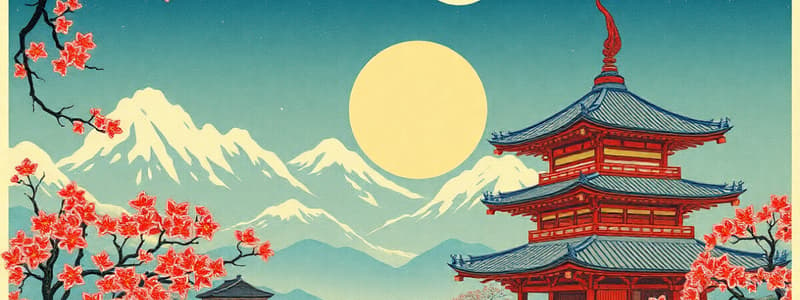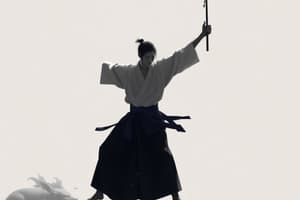Podcast
Questions and Answers
What subjects are commonly depicted in traditional Chinese paintings?
What subjects are commonly depicted in traditional Chinese paintings?
- Abstract shapes and patterns
- Sports and warfare
- Flowers and birds, Landscapes, Human Figures (correct)
- Mythical creatures and astrology
What are the two methods of brushwork in traditional Chinese painting?
What are the two methods of brushwork in traditional Chinese painting?
- Gong Bi and Yi Bi (correct)
- Impressionistic and Cubist
- Pointillism and Fauvism
- Chiaroscuro and Sfumato
Which medium became widespread and economical for painting due to its invention in the 1st Century AD?
Which medium became widespread and economical for painting due to its invention in the 1st Century AD?
- Wood panels
- Paper (correct)
- Silk
- Canvas
What aspect of Korean landscape painting is emphasized alongside landscapes?
What aspect of Korean landscape painting is emphasized alongside landscapes?
What are the three concepts that East Asian painting emphasizes?
What are the three concepts that East Asian painting emphasizes?
What is considered the highest form of Chinese painting?
What is considered the highest form of Chinese painting?
Which traditional aspect of Korean painting was heavily influenced by Chinese art?
Which traditional aspect of Korean painting was heavily influenced by Chinese art?
What is the relationship between painting and calligraphy in Chinese culture?
What is the relationship between painting and calligraphy in Chinese culture?
What traditional Japanese woodblock printing technique significantly influenced Western artists such as Vincent van Gogh?
What traditional Japanese woodblock printing technique significantly influenced Western artists such as Vincent van Gogh?
Which Japanese craft symbolizes simplicity, patience, and precision while having spiritual significance?
Which Japanese craft symbolizes simplicity, patience, and precision while having spiritual significance?
In traditional Japanese performing arts, what role do masks and face painting play?
In traditional Japanese performing arts, what role do masks and face painting play?
What is the primary distinguishing feature of anime characters?
What is the primary distinguishing feature of anime characters?
What are the typical characteristics of manga styles in Japan?
What are the typical characteristics of manga styles in Japan?
During which historical period did woodblock printing known as Ukiyo-e originate?
During which historical period did woodblock printing known as Ukiyo-e originate?
Which of the following does NOT typically serve as a motif in East Asian paintings?
Which of the following does NOT typically serve as a motif in East Asian paintings?
How do anime and manga reflect contemporary Japanese culture?
How do anime and manga reflect contemporary Japanese culture?
Which materials are commonly used in traditional painting and calligraphy?
Which materials are commonly used in traditional painting and calligraphy?
What is the significance of the term 'jiaguwen'?
What is the significance of the term 'jiaguwen'?
What influence did the Chinese have on Japanese knot tying?
What influence did the Chinese have on Japanese knot tying?
What is a defining characteristic of Korean ornamental knots?
What is a defining characteristic of Korean ornamental knots?
Which aspect is commonly associated with Chinese paper cutting?
Which aspect is commonly associated with Chinese paper cutting?
What does the term 'yuanbao' refer to in traditional Chinese funerals?
What does the term 'yuanbao' refer to in traditional Chinese funerals?
What purpose does burning yuanbao serve during funerals?
What purpose does burning yuanbao serve during funerals?
How are traditional face paintings in East Asia distinctive?
How are traditional face paintings in East Asia distinctive?
What is the primary function of face painting in both Kabuki and Peking Opera?
What is the primary function of face painting in both Kabuki and Peking Opera?
Which of the following colors in Kabuki makeup represents nobility?
Which of the following colors in Kabuki makeup represents nobility?
What type of makeup is applied to villains and heroes in Kabuki theater?
What type of makeup is applied to villains and heroes in Kabuki theater?
Which mask-making tradition is rooted in shamanistic rituals in Korea?
Which mask-making tradition is rooted in shamanistic rituals in Korea?
What does the color Dark Blue signify in Kabuki makeup?
What does the color Dark Blue signify in Kabuki makeup?
How are hero-type characters typically painted in Peking Opera?
How are hero-type characters typically painted in Peking Opera?
What is the purpose of using masks in Korean funerals?
What is the purpose of using masks in Korean funerals?
What is a defining characteristic of Mukimiguma makeup in Kabuki?
What is a defining characteristic of Mukimiguma makeup in Kabuki?
Flashcards
Ukiyo-e
Ukiyo-e
A traditional Japanese woodblock printing technique popular during the Edo period (17th-19th centuries).
Origami
Origami
The Japanese art of paper folding, often with spiritual significance and symbolic meaning.
Theater Masks/Face Painting
Theater Masks/Face Painting
Used in traditional Japanese performing arts like Noh and Kabuki to portray characters and emotions.
Anime
Anime
Signup and view all the flashcards
Manga
Manga
Signup and view all the flashcards
Subjects/Themes/Motifs in paintings
Subjects/Themes/Motifs in paintings
Signup and view all the flashcards
Edo Period
Edo Period
Signup and view all the flashcards
Western Influence on Ukiyo-e
Western Influence on Ukiyo-e
Signup and view all the flashcards
Jiaguwen
Jiaguwen
Signup and view all the flashcards
Cangjie
Cangjie
Signup and view all the flashcards
Zhongguo Knot Tying
Zhongguo Knot Tying
Signup and view all the flashcards
Hanamusubi Knot Tying
Hanamusubi Knot Tying
Signup and view all the flashcards
Maedeup Knot Tying
Maedeup Knot Tying
Signup and view all the flashcards
Paper Cutting (China)
Paper Cutting (China)
Signup and view all the flashcards
Jianzi
Jianzi
Signup and view all the flashcards
Yuanbao
Yuanbao
Signup and view all the flashcards
East Asian Painting Subjects
East Asian Painting Subjects
Signup and view all the flashcards
Chinese Landscape Painting
Chinese Landscape Painting
Signup and view all the flashcards
Korean Landscape Painting
Korean Landscape Painting
Signup and view all the flashcards
Chinese and Korean Painting Influence
Chinese and Korean Painting Influence
Signup and view all the flashcards
Calligraphy in Chinese Culture
Calligraphy in Chinese Culture
Signup and view all the flashcards
Early Painting Subjects
Early Painting Subjects
Signup and view all the flashcards
Painting Medium: Silk
Painting Medium: Silk
Signup and view all the flashcards
Paper in East Asian Painting
Paper in East Asian Painting
Signup and view all the flashcards
Peking Opera Face Painting
Peking Opera Face Painting
Signup and view all the flashcards
Hero Characters in Peking Opera
Hero Characters in Peking Opera
Signup and view all the flashcards
Kabuki Makeup
Kabuki Makeup
Signup and view all the flashcards
Standard Kabuki Makeup
Standard Kabuki Makeup
Signup and view all the flashcards
Kumadori Kabuki Makeup
Kumadori Kabuki Makeup
Signup and view all the flashcards
Mukimiguma Makeup
Mukimiguma Makeup
Signup and view all the flashcards
Sujiguma Makeup
Sujiguma Makeup
Signup and view all the flashcards
Korean Tal (Masks)
Korean Tal (Masks)
Signup and view all the flashcards
Study Notes
Arts & Crafts in East Asian Countries
- Woodblock Printing (Japan): Known as Ukiyo-e, this 17th-19th century technique depicted daily life, kabuki actors, landscapes, and beautiful women. It was popular and affordable, influencing Western artists like Van Gogh and Monet.
- Origami (Japan): The art of paper folding, rooted in Japanese culture, symbolizes simplicity, patience, and precision. Common models include flowers, animals, and geometric shapes. Used in traditional ceremonies, including weddings and funerals.
- Theater Masks/Face Painting (Japan): A common practice in traditional Japanese performing arts like Noh and Kabuki, masks and face painting use elaborate, symbolic designs to convey character and emotions to the audience.
- Anime and Manga (Japan): Contemporary artistic forms with global popularity, reflecting modern Japanese culture and societal concerns, as well as technology. Themes range from fantasy and science fiction to romance and slice-of-life. Anime is hand-drawn or computer animation, while Manga are comics/graphic novels. Manga characters have noticeable characteristics like large eyes and small mouths.
Arts & Crafts in China, Japan, and Korea
- Subjects/Themes/Motifs (China, Japan, and Korea): Paintings often depict animals, people, landscapes, and environment. Early paintings featured hunting scenes (including various animals). The history of East Asian painting is long and the cultures continued to influence each other's art.
- Painting Subjects/Themes (China): Often features flowers, birds, landscapes, palaces, temples, human figures, animals, bamboos, and stones.
- Painting Subjects/Themes (Japan): Displays everyday life and narrative scenes, densely populated with details and figures.
- Painting Subjects/Themes (Korea): Known for landscape paintings, traditional folk painting (Minhwa), four graceful plants (plum blossoms, orchids, chrysanthemums, bamboo), and portraits.
- Important Aspects (East Asian Painting): Landscape painting was highly regarded in China. Two common brush techniques, Gong Bi (fine strokes) and Yi Bi (rough strokes), existed.
- Silk in East Asian Painting: A common medium, but silk was expensive, so the invention of paper made painting more accessible.
- Calligraphy: A significant aspect of Chinese culture, often used with similar techniques to painting. Used ink and brushes, and the medium was often paper or silk.
- Knot-Tying (China, Japan, Korea): Traditional forms of handicraft, often with symbolic and decorative purposes. Examples include Zhongguo (China), Hanamusubi (Japan), Maedeup (Korea).
- Paper Cutting (China): A popular art form involving symmetrical shapes and motifs from the Chinese zodiac, often in red, to bring good luck. Jianzi is one common style.
- Paper Folding (China): A practice relating to funerals, with folded paper representing gold currency or ingots (sycees).
Peking and Kabuki Face Painting & Korean Masks
- Peking Opera Face Painting (China): This form of face painting used different colours based on the character's personality to convey meaning and historical context. Heroes or historical characters are typically painted in simpler colours.
- Kabuki Makeup (Japan): Actors used makeup for interpretation of a role, and two categories exist: standard (for most actors) and Kumadori (villains or heroes) - with colours representing traits. (e.g., red for passion/anger, blue for sadness.)
- Korean Masks (Korea): Masks with specific meaning in rituals and traditions. They, as well as paintings, were used in ceremonies and plays - often in connection with shrines/temples. Certain colours indicate elements like age, racial ties and even lineage.
Studying That Suits You
Use AI to generate personalized quizzes and flashcards to suit your learning preferences.




